
Vsemirny_doklad_o_torgovle_lyudmi_2015
.pdf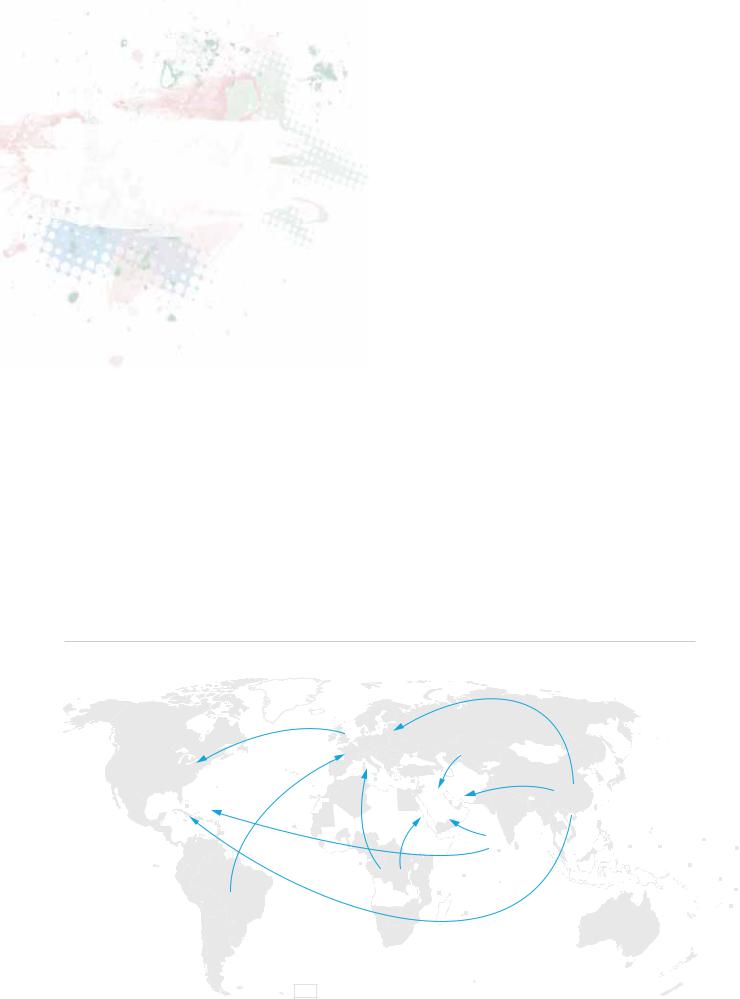
EXECUTIVE SUMMARY
1. TRAFFICKING IN PERSONS HAPPENS EVERYWHERE
The crime of trafficking in persons affects virtually every country in every region of the world. Between 2010 and 2012, victims with 152 different citizenships were identified in 124 countries across the globe. Moreover, trafficking flows - imaginary lines that connect the same origin country and destination country of at least five detected victims – criss-cross the world. UNODC has identified at least 510 flows. These are minimum figures as they are based on official data reported by national authorities. These official figures represent only the visible part of the trafficking phenomenon and the actual figures are likely to be far higher.
Most trafficking flows are intraregional, meaning that the origin and the destination of the trafficked victim is within
the same region; often also within the same subregion. For this reason, it is difficult to identify major global trafficking hubs. Victims tend to be trafficked from poor countries to more affluent ones (relative to the origin country) within the region.
Transregional trafficking flows are mainly detected in the rich countries of the Middle East, Western Europe and North America. These flows often involve victims from the ‘global south’; mainly East and South Asia and SubSaharan Africa. Statistics show a correlation between the affluence (GDP) of the destination country and the share of victims trafficked there from other regions. Richer countries attract victims from a variety of origins, including from other continents, whereas less affluent countries are mainly affected by domestic or subregional trafficking flows.
Main destination areas of transregional trafficking flows (in blue) and their significant origins,
2010-2012
The arrows show the flows that represent 5% and above of the total victims detected in destination subregions
Western |
|
Eastern |
|
and Central |
|
and Central |
|
|
Europeans |
||
Europe |
|
||
|
|
||
North America, |
|
|
|
Central America |
|
East |
|
and the Caribbean |
The Middle |
||
Asians |
|||
|
East |
||
|
|
||
|
|
South |
|
|
|
Asians |
Sub-Saharan
Africans
South
Americans
Sciences Po - Atelier de cartographie, 2014
countries not covered
Source: UNODC.
7
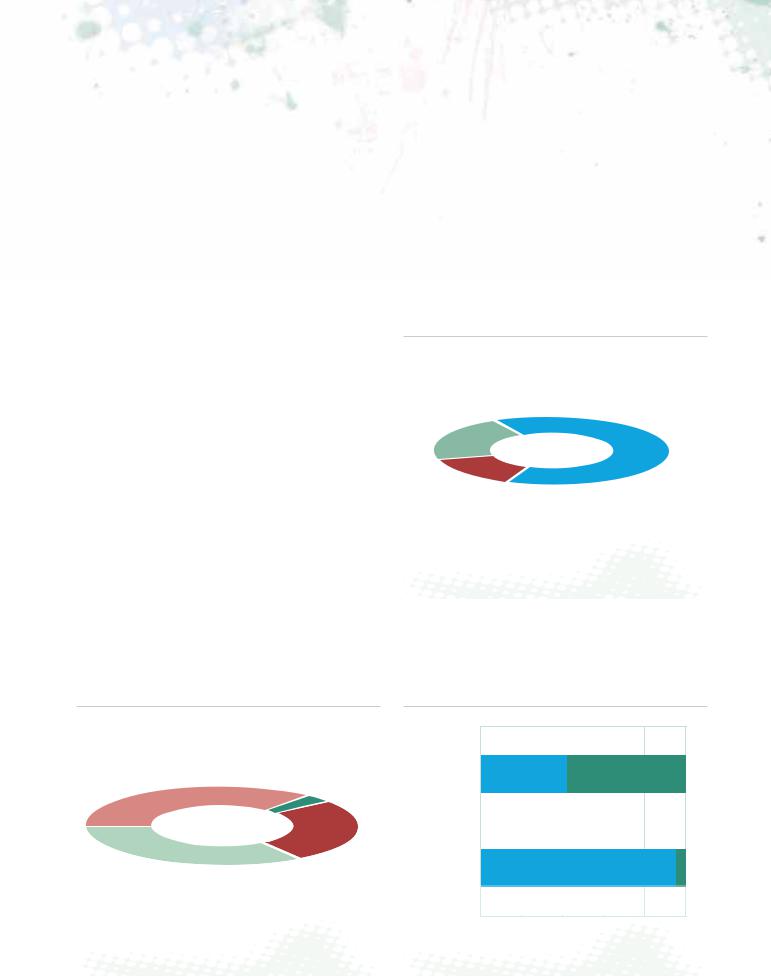
GLOBAL REPORT ON TRAFFICKING IN PERSONS 2014
2. A TRANSNATIONAL CRIME THAT OFTEN INVOLVES DOMESTIC OFFENDERS AND LIMITED GEOGRAPHICAL REACH
Most victims of trafficking in persons are foreigners in the country where they are identified as victims. In other words, these victims - more than 6 in 10 of all victims - have been trafficked across at least one national border. That said, many trafficking cases involve limited geographic movement as they tend to take place within a subregion (often between neighbouring countries). Domestic trafficking is also widely detected, and for one in three trafficking cases, the exploitation takes place in the victim’s country of citizenship.
A majority of the convicted traffickers, however, are citizens of the country of conviction. These traffickers were convicted of involvement in domestic as well as transnational trafficking schemes.
Dividing countries into those that are more typical origin countries and those that are more typical destinations for trafficking in persons reveals that origin countries convict almost only their own citizens. Destination countries, on the other hand, convict both their own citizens and foreigners.
Breakdown of trafficking flows by geographical reach, 2010-2012 (or more recent)
CROSS-BORDER WITHIN |
FROM NEARBY |
SAME SUBREGION |
SUBREGION |
37% |
3% |
DOMESTIC |
TRANSREGIONAL |
|
(WITHIN NATIONAL BORDERS) |
26% |
|
34% |
||
|
Source: UNODC elaboration on national data.
Moreover, there is a correlation between the citizenships of the victims and the traffickers involved in cross-border trafficking. This correlation indicates that the offenders often traffic fellow citizens abroad.
Citizenship of convicted traffickers globally,
2010-2012 (or more recent); shares of local and foreign nationals (relative to the country of conviction)
FOREIGNERS FROM COUNTRIES NATIONALS |
||
IN THE SAME REGION |
64% |
|
22% |
||
|
||
FOREIGNERS FROM OTHER REGIONS
14%
Source: UNODC elaboration on national data.
Distribution of national and foreign offenders among countries of origin and destination of cross-border trafficking,
2010-2012 (or more recent)
|
NATIONAL OFFENDERS |
|
Countries of |
|
|
destination |
42% |
58% |
|
FOREIGN OFFENDERS
Countries of |
95% 5% |
origin |
|
0% 20% |
40% 60% 80% 100% |
Source: UNODC elaboration on national data.
8
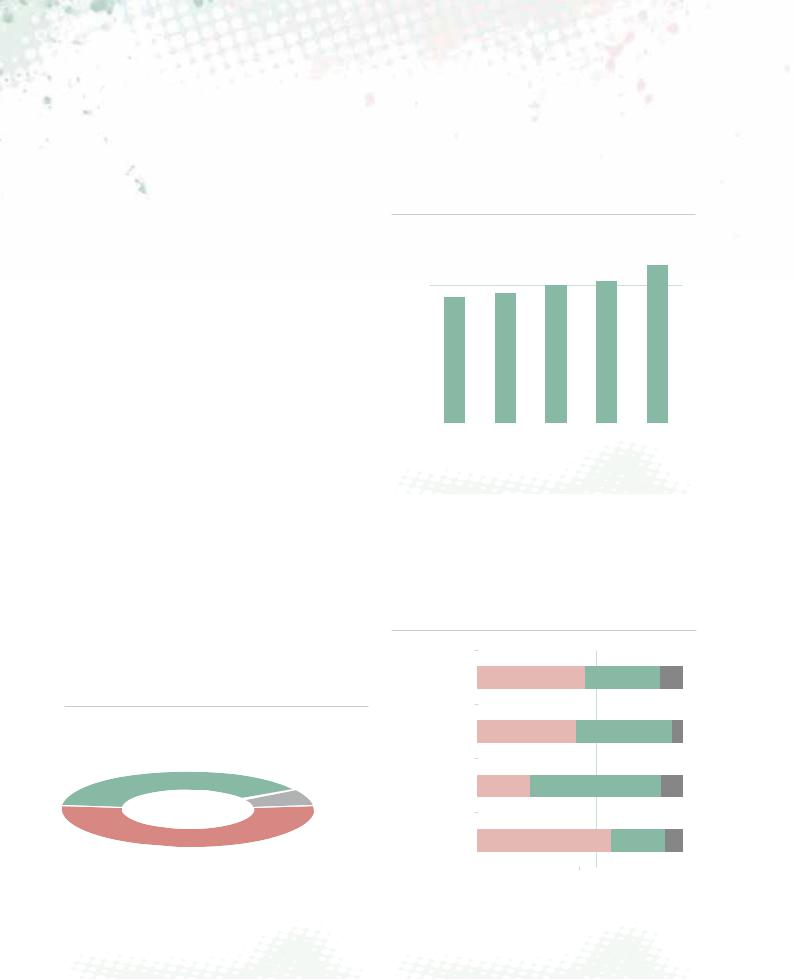
3. INCREASED DETECTION OF TRAFFICKING IN PERSONS FOR PURPOSES OTHER THAN SEXUAL EXPLOITATION
While a majority of trafficking victims are subjected to sexual exploitation, other forms of exploitation are increasingly detected. Trafficking for forced labour - a broad category which includes, for example, manufacturing, cleaning, construction, catering, restaurants, domestic work and textile production – has increased steadily in recent years. Some 40 per cent of the victims detected between 2010 and 2012 were trafficked for forced labour.
Trafficking for exploitation that is neither sexual nor forced labour is also increasing. Some of these forms, such as trafficking of children for armed combat, or for petty crime or forced begging, can be significant problems in some locations, although they are still relatively limited from a global point of view.
There are considerable regional differences with regard to forms of exploitation. While trafficking for sexual exploitation is the main form detected in Europe and Central Asia, in East Asia and the Pacific, it is forced labour. In the Americas the two types are detected in near equal proportions.
Executive summary
Share of the total number of detected victims who were trafficked for forced labour, 20072011
45% |
|
|
|
|
|
|
|
|
|
|
|
|
|
|
|
|
|
|
|
|
40% |
|
|||
|
|
|
|
|
|
|
|
|
|
|
||
40% |
|
|
|
|
|
|
|
|
|
|
|
|
|
|
33% |
35% |
36% |
|
|
|
|||||
|
|
32% |
|
|
|
|
|
|||||
35% |
|
|
|
|
|
|
|
|
||||
|
|
|
|
|
|
|
|
|
|
|||
30% |
|
|
|
|
|
|
|
|
|
|
|
|
|
|
|
|
|
|
|
|
|
|
|
||
25% |
|
|
|
|
|
|
|
|
|
|
|
|
|
|
|
|
|
|
|
|
|
|
|
||
20% |
|
|
|
|
|
|
|
|
|
|
|
|
|
|
|
|
|
|
|
|
|
|
|
||
15% |
|
|
|
|
|
|
|
|
|
|
|
|
|
|
|
|
|
|
|
|
|
|
|
||
10% |
|
|
|
|
|
|
|
|
|
|
|
|
|
|
|
|
|
|
|
|
|
|
|
||
5% |
|
|
|
|
|
|
|
|
|
|
|
|
|
|
|
|
|
|
|
|
|
|
|
||
0% |
|
|
|
|
|
|
|
|
|
|
|
|
|
2007 |
2008 |
2009 |
2010 |
2011 |
|
||||||
|
|
|
||||||||||
Source: UNODC elaboration on national data.
Forms of exploitation among detected trafficking victims, by region of detection,
2010-2012 (or more recent)
Forms of exploitation among detected trafficking victims, 2011*
FORCED
LABOUR
40%
SEXUAL EXPLOITATION
53%
Source: UNODC elaboration on national data.
ORGAN REMOVAL
0.3%
OTHERS
7%
*Please note that the regional differences in detection capacities and definitions – particularly for forced labour – affect the global shares.
Africa and |
53% |
|
|
|
|
37% |
|
|
10% |
|
|||
the Middle East |
|
|
|
|
|
|
|
||||||
Americas |
48% |
|
|
|
|
47% |
|
|
4% |
|
|||
|
|
|
|
|
|
|
|
|
|||||
East Asia, |
|
|
|
|
|
|
|
|
|
|
|
|
|
South Asia |
26% |
|
|
64% |
|
|
|
|
|
|
10% |
|
|
and Pacific |
|
|
|
|
|
|
|
|
|
||||
|
|
|
|
|
|
|
|
|
|
|
|
||
Europe and |
66% |
|
|
|
|
|
|
|
26% |
|
8% |
|
|
Central Asia |
|
|
|
|
|
|
|
|
|
||||
|
|
|
|
|
|
|
|
|
|
|
|
|
|
0% |
20% |
40% |
60% |
80% |
100% |
||||||||
|
|
Sexual exploitation |
|
|
Organ removal |
||||||||
|
|
|
|
||||||||||
|
|
|
|
||||||||||
|
|
Forced labour, |
|
|
Other forms |
||||||||
|
|
|
|
||||||||||
|
|
|
|
||||||||||
|
|
servitude and |
|
|
of exploitation |
||||||||
|
|
slavery like |
|
|
|
|
|
|
|
||||
Source: UNODC elaboration on national data.
9
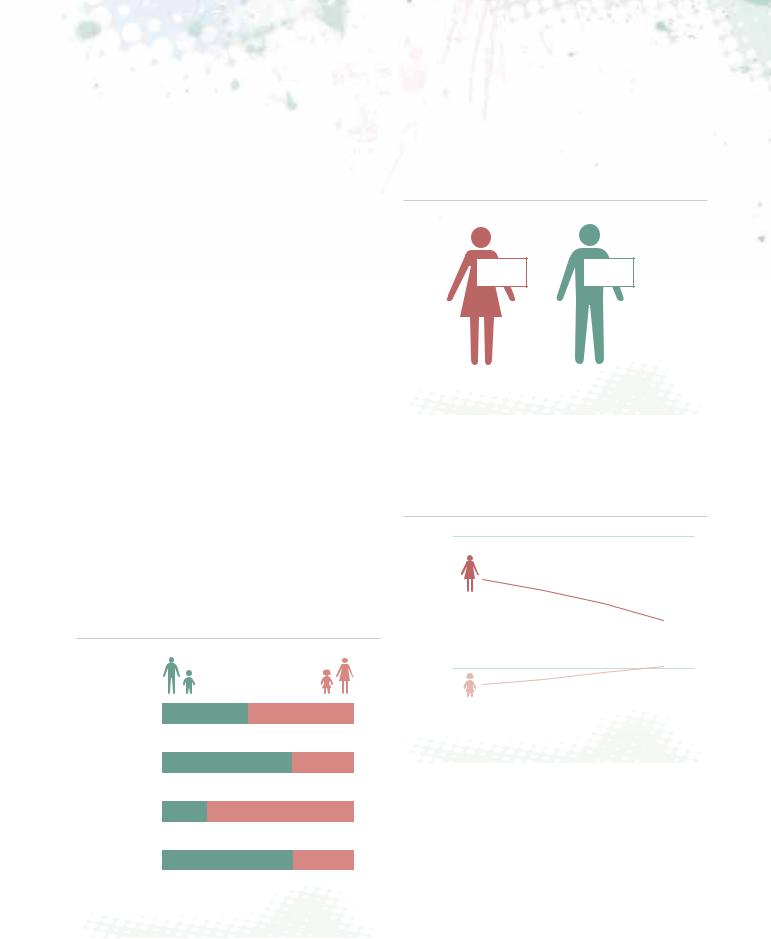
GLOBAL REPORT ON TRAFFICKING IN PERSONS 2014
4. WOMEN ARE SIGNIFICANTLY INVOLVED IN TRAFFICKING IN PERSONS, BOTH AS VICTIMS AND AS OFFENDERS
For nearly all crimes, male offenders vastly outnumber females. On average, some 10-15 per cent of convicted offenders are women. For trafficking in persons, however, even though males still comprise the vast majority, the share of women offenders is nearly 30 per cent.
Moreover, approximately half of all detected trafficking victims are adult women. Although this share has been declining significantly in recent years, it has been partially offset by the increasing detection of victims who are girls.
Women comprise the vast majority of the detected victims who were trafficked for sexual exploitation. Looking at victims trafficked for forced labour, while men comprise a significant majority, women make up nearly one third of detected victims. In some regions, particularly in Asia, most of the victims of trafficking for forced labour were women.
Gender breakdown of detected victims of trafficking for forced labour, by region,
2010-2012 (or more recent)
Africa and |
45% |
|
|
|
|
|
|
|
55% |
|
|
Middle East |
|
|
|
|
|
|
|
|
|||
|
|
|
|
|
|
|
|
|
|
|
|
Americas |
68% |
|
|
|
|
|
|
|
32% |
|
|
|
|
|
|
|
|
|
|
|
|
|
|
South Asia, |
|
|
|
|
|
|
|
|
|
|
|
East Asia and |
23% |
|
|
|
|
|
|
|
77% |
|
|
the Pacific |
|
|
|
|
|
|
|
|
|||
|
|
|
|
|
|
|
|
|
|
|
|
Europe and |
69% |
|
|
|
|
|
|
|
31% |
|
|
Central Asia |
|
|
|
|
|
|
|
|
|||
|
|
|
|
|
|
|
|
|
|
|
|
|
|
|
|
|
|
|
|
|
|
|
|
0% |
20% |
40% |
60% |
80% |
100% |
||||||
Source: UNODC elaboration on national data.
Persons convicted for trafficking in persons, by gender, 2010-2012 (or more recent)
28% 72%
Source: UNODC elaboration on national data.
Trends in the shares of females (women and girls) among the total number of detected victims, 2004-2011
100%
80% |
|
|
|
|
|
|
|
|
|
|
|
|
|
|
|
74% |
|
|
67% |
|
|
|
|
|
|
||
|
|
|
|
|
|
|
|
|
|
|
|
||
|
|
|
|
|
|
|
|
|
|
|
|
|
|
60% |
|
|
|
|
|
|
|
|
|
59% |
|
|
|
|
|
|
|
|
|
|
|
49% |
|
||||
|
|
|
|
|
|
|
|
|
|
|
|||
40% |
|
|
|
|
|
|
|
|
|
|
|
|
|
|
|
|
|
|
|
|
|
|
|
|
|
||
20% |
|
|
|
|
|
|
|
|
|
21% |
|
||
|
|
|
|
10% |
|
|
13% |
|
|
17% |
|
|
|
|
|
|
|
|
|
|
|
|
|
|
|
||
0% |
|
|
|
|
|
|
|
|
|
|
|
|
|
|
|
|
|
|
|
|
|
|
|
|
|
|
|
|
|
|
|
|
|
|
|
|
|
|
|
|
|
2004 |
2006 |
2009 |
2011 |
|
|||||||||
Source: UNODC elaboration on national data.
10
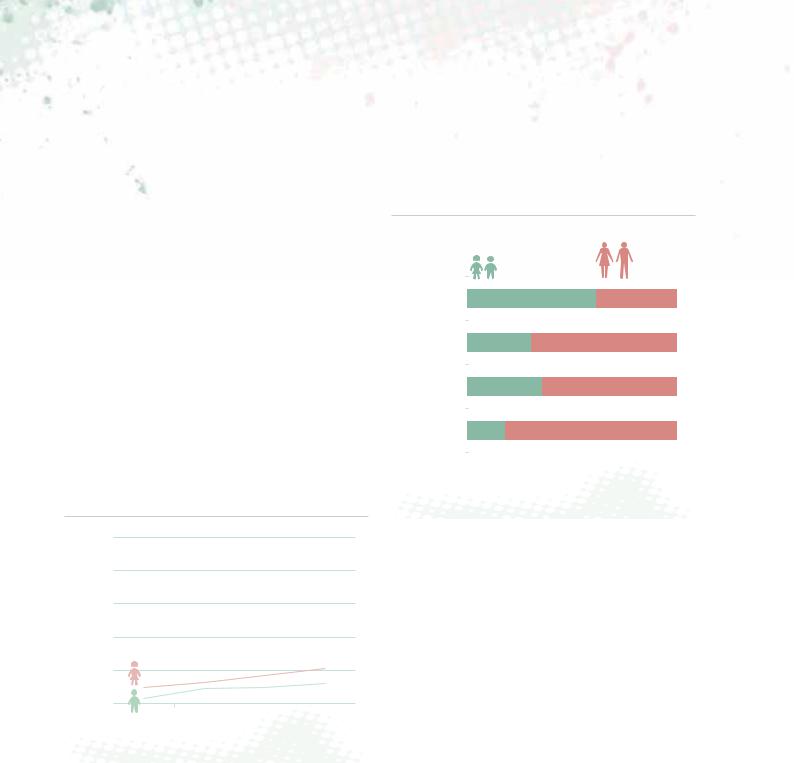
5. DETECTED CHILD TRAFFICKING IS INCREASING
Since UNODC started to collect information on the age profile of detected trafficking victims, the share of children among the detected victims has been increasing. Globally, children now comprise nearly one third of all detected trafficking victims. Out of every three child victims, two are girls and one is a boy.
The global figure obscures significant regional differences. In some areas, child trafficking is the major traffickingrelated concern. In Africa and the Middle East, for example, children comprise a majority of the detected victims. In Europe and Central Asia, however, children are vastly outnumbered by adults (mainly women).
Trends in the shares of children (girls and boys) among the total number of detected victims, 2004-2011
100%
80%
60%
40%
20% |
|
|
|
13% |
|
17% |
21% |
||
|
10% |
|
|
|
|||||
|
|
|
|
|
|
|
12% |
||
|
|
|
|
|
|
|
10% |
||
0% |
|
3% |
|
9% |
|
|
|||
|
|
|
|
|
|
|
|
||
|
|
|
|
|
|
|
|
|
|
2004 |
|
|
2006 |
|
2009 |
|
|
2011 |
|
Source: UNODC elaboration on national data.
Executive summary
Shares of children and adults among the detected victims of trafficking in persons, by region, 2010-2012 (or more recent)
Africa and |
|
|
CHILDREN |
|
|
|
|
ADULTS |
|
||
|
|
|
|
|
|
|
|||||
62% |
|
|
|
|
|
|
|
38% |
|
||
Middle East |
|
|
|
|
|
|
|
|
|||
Americas |
31% |
|
|
|
|
|
|
|
69% |
|
|
South Asia, |
36% |
|
|
|
|
|
|
|
64% |
|
|
East Asia and |
|
|
|
|
|
|
|
|
|||
the Pacific |
|
|
|
|
|
|
|
|
|
|
|
Europe and |
18% |
|
|
|
|
|
|
|
82% |
|
|
Central Asia |
|
|
|
|
|
|
|
|
|||
|
|
|
|
|
|
|
|
|
|
|
|
|
|
|
|
|
|
|
|
|
|
|
|
0% |
20% |
40% |
60% |
80% |
100% |
||||||
Source: UNODC elaboration on national data.
11
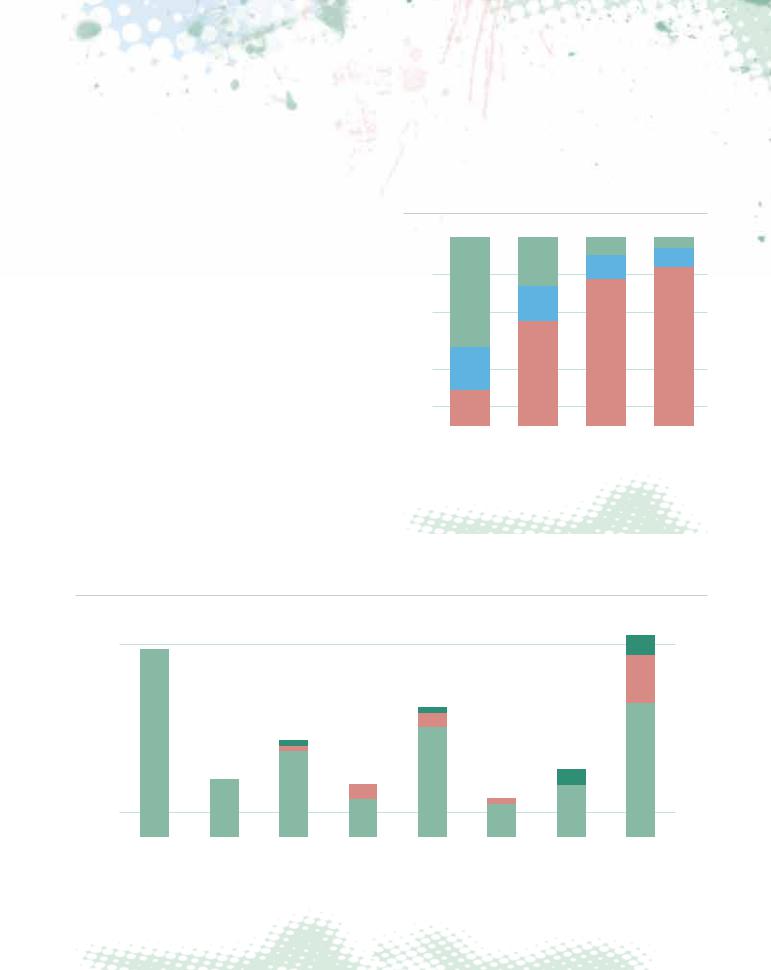
GLOBAL REPORT ON TRAFFICKING IN PERSONS 2014
6. MORE THAN 2 BILLION PEOPLE ARE NOT PROTECTED AS REQUIRED BY THE UNITED NATIONS TRAFFICKING IN PERSONS PROTOCOL
More than 90 per cent of countries among those covered by UNODC criminalize trafficking in persons. Many countries have passed new or updated legislation since the entry into force of the United Nations Protocol against Trafficking in Persons in 2003.
Although this legislative progress is remarkable, much work remains. 9 countries still lack legislation altogether, whereas 18 others have partial legislation that covers only some victims or certain forms of exploitation. Some of these countries are large and densely populated, which means that more than 2 billion people lack the full protection of the Trafficking in Persons Protocol.
Criminalization of trafficking in persons with a specific offence, shares and numbers of countries, 2003-2014
100% |
|
|
|
|
9 (5%) |
|
|
|
|
16 (9%) |
|
||
|
|
|
|
|
||
90% |
|
|
|
18 |
|
|
|
|
44 |
22 |
(10.5%) |
|
|
|
|
|
|
|||
80% |
|
|
(13%) |
|
|
|
|
|
(25.5%) |
|
|
||
|
|
|
|
|
||
|
|
|
|
|
|
|
70% |
|
|
|
|
|
|
|
|
32 |
|
|
|
|
60% |
|
|
|
|
|
|
|
100 |
(18.5%) |
|
|
|
|
50% |
|
|
|
|
|
|
|
(58%) |
|
|
|
|
|
40% |
|
|
|
|
|
|
|
|
|
|
|
|
|
|
|
|
|
|
|
|
30% |
|
40 |
|
|
|
|
20% |
|
(23%) |
|
|
|
|
|
|
|
|
|
|
|
10% |
|
33 |
97 |
135 |
146 |
|
0% |
|
(19%) |
(56%) |
(78%) |
(84.5%) |
|
|
November |
November |
August |
August |
||
|
|
|||||
|
2003 |
2008 |
2012 |
2014 |
|
|
 Most/all forms
Most/all forms
 Partial
Partial
 No specific offence
No specific offence
Source: UNODC elaboration on national data.
Criminalization of trafficking in persons with a specific offence, numbers of countries, by subregion, 2014
45 |
|
|
|
|
|
|
|
|
|
|
|
|
|
|
|
|
|
|
|
|
|
|
|
|
|
|
|
|
|
|
|
|
|
|
|
40 |
|
|
|
|
|
|
|
|
|
|
|
|
|
|
|
|
4 |
35 |
|
|
|
|
|
|
|
|
|
|
|
|
|
|
|
|
|
|
|
|
|
|
|
|
|
|
|
|
|
|
|
|
|
10 |
|
|
|
|
|
|
|
|
|
|
|
|
|
|
|
|
|
|
|
30 |
|
|
|
|
|
|
|
|
|
|
|
|
|
|
|
|
|
|
|
|
|
|
|
|
|
|
|
1 |
|
|
|
|
|
||
25 |
|
|
|
|
|
|
|
|
|
|
|
|
|
|
|||
|
|
|
|
|
|
|
|
|
3 |
|
|
|
|
|
|||
|
|
|
|
|
|
|
|
|
|
|
|
|
|
|
|||
20 |
|
|
|
|
|
|
|
|
|
|
|
|
|
|
|
|
|
39 |
|
1 |
|
|
|
|
|
|
|
|
|
|
|
|
|
||
|
|
|
1 |
|
|
|
|
|
|
|
|
|
|
|
|
|
|
15 |
|
|
|
|
|
|
|
|
|
|
|
|
|
|
|
|
|
|
|
|
|
|
|
|
|
|
23 |
|
|
3 |
28 |
||||
|
|
|
|
|
|
|
|
|
|
|
|
||||||
10 |
|
|
|
|
|
3 |
|
|
|
|
|
|
|||||
|
|
|
|
|
|
|
|
|
|
|
|
||||||
|
|
18 |
|
|
|
|
|
|
|
|
|
1 |
|
|
|||
5 |
|
12 |
|
|
|
|
|
|
|
|
|
|
|
|
11 |
|
|
|
|
|
|
8 |
|
|
|
|
|
|
|
|
|
|
|||
|
|
|
|
|
|
|
|
|
|
|
|
|
7 |
|
|||
|
|
|
|
|
|
|
|
|
|
|
|
|
|
|
|
||
0 |
|
|
|
|
|
|
|
|
|
|
|
|
|
|
|
|
|
Western |
Eastern |
|
North and |
|
South |
East Asia |
South Asia |
North Africa |
Subsahara |
||||||||
|
|
|
|||||||||||||||
|
and Central |
Europe and |
|
Central |
America |
and the |
|
and Middle |
Africa |
||||||||
|
Europe |
Central Asia |
America and |
|
|
|
|
|
|
Pacific |
|
East |
|
||||
|
|
|
the Caribbean |
|
|
|
|
|
|
|
|
|
|
|
|
|
|
|
|
|
|
Most/all forms |
|
|
|
Partial |
|
|
|
No specific offence |
|
|
|||
|
|
|
|
|
|
|
|
|
|
|
|||||||
|
|
|
|
|
|
|
|
|
|
|
|||||||
Source: UNODC elaboration on national data.
12
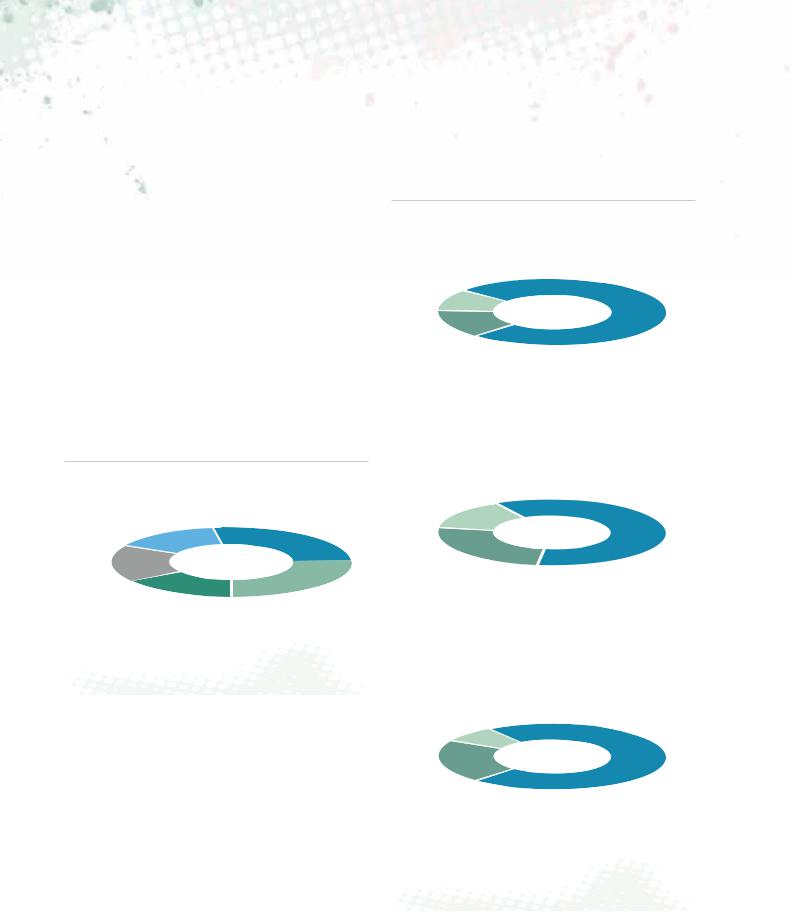
7. IMPUNITY PREVAILS
In spite of the legislative progress mentioned above, there are still very few convictions for trafficking in persons. Only 4 in 10 countries reported having 10 or more yearly convictions, with nearly 15 per cent having no convictions at all.
The global picture of the criminal justice response has remained largely stable in recent years. Fewer countries are reporting increases in the numbers of convictions which remain very low. This may reflect the difficulties of the criminal justice systems to appropriately respond to trafficking in persons.
Number of convictions recorded per year, share of countries, 2010-2012
|
LESS THAN TEN |
NO CONVICTIONS |
CONVICTIONS |
15% |
26% |
INFORMATION |
|
BETWEEN 10 AND |
NOT AVAILABLE MORE THAN 50 |
||
17% |
CONVICTIONS |
50 CONVICTIONS |
|
16% |
26% |
Source: UNODC elaboration on national data.
Executive summary
Trends in the number of recorded convictions, share of countries
2010-2012
DECREASING TRENDS
10%
INCREASING |
STABLE OR |
|
TRENDS |
||
UNCLEAR TRENDS |
||
13% |
||
77% |
||
|
2007-2010 |
|
DECREASING |
|
|
TRENDS |
|
|
15% |
|
|
INCREASING |
STABLE OR |
|
TRENDS |
UNCLEAR TRENDS |
|
25% |
60% |
|
|
2003-2007 |
|
DECREASING |
|
|
TRENDS |
|
|
8% |
|
|
INCREASING |
STABLE OR |
|
TRENDS |
UNCLEAR TRENDS |
|
21% |
71% |
Sources: UN.GIFT/UNODC, Global Report on Trafficking in Persons 2009 (2003-2007); UNODC, elaboration on national data (2007-2010 and 2010-2012).
13

8. ORGANIZED CRIME INVOLVEMENT: TOWARDS A TYPOLOGY
Criminals committing trafficking in persons offences can act alone, with a partner or in different types of groups and networks. Human trafficking can be easily conducted by single individuals with a limited organization in place. This is particularly true if the crime involves only a few victims who are exploited locally. But trafficking operations can also be complex and involve many offenders, which is often the case for transregional trafficking flows.
Offenders may traffic their victims across regions to more affluent countries in order to increase their profits. However, doing so increases their costs as well as the risks of law enforcement detection. It also requires more organization, particularly when there are several victims. Crossborder trafficking flows – subregional and transregional
– are more often connected to organized crime. Complex
trafficking flows can be more easily sustained by large and well-organized criminal groups.
The transnational nature of the flows, the victimization of more persons at the same time, and the endurance in conducting the criminal activity are all indicators of the level of organization of the trafficking network behind the flow. On this basis, a typology including three different trafficking types is emerging. The trafficking types have some typical characteristics; however, as always, typologies are based on categorization to better explain and understand different aspects of trafficking. ‘Pure’ trafficking types may not exist since there is always some overlap between different types.
Typology on the organization of trafficking in persons
SMALL LOCAL OPERATIONS |
MEDIUM SUBREGIONAL OPERATIONS |
LARGE TRANSREGIONAL OPERATIONS |
|
|
|
Domestic or short-distance trafficking |
Trafficking flows within the subregion or |
flows. |
neighboring subregions. |
Long distance trafficking flows involving different regions.
One or few traffickers. |
Small group of traffickers. |
Traffickers involved in organized crime. |
|
|
|
|
|
Small number of victims. |
More than one victim. |
Large number of victims. |
|
|
|
|
|
Intimate partner exploitation. |
Some investments and some profits |
High investments and high profits. |
|
depending on the number of victims. |
|||
|
|
||
|
|
|
|
Limited investment and profits. |
Border crossings with or without travel doc- |
Border crossings always require travel |
|
uments. |
documents. |
||
|
|||
|
|
|
|
No travel documents needed for |
Some organization needed depending on |
Sophisticated organization needed to move |
|
border crossings. |
the border crossings and number of victims. |
large number of victims long distance. |
|
|
|
|
|
No or very limited organization required. |
|
Endurance of the operation. |
|
|
|
|
14

INTRODUCTION
TRAFFICKERS, ORGANIZED CRIME AND THE BUSINESS OF EXPLOITATION
The crime of trafficking in persons is carried out by different types of traffickers, ranging from individuals exploiting their partner to organized criminal groups operating across national borders. Trafficking in persons is usually thought of as a ‘transnational organized crime.’1 And indeed, many trafficking outfits meet the criteria of transnational organized crime groups, as spelled out in the United Nations Convention against Transnational Organized Crime.2 Aspects of the crime are often committed in different countries by criminals not necessarily hailing from the country where the crime was detected. These criminals may have organized themselves to a lesser or greater extent. In some cases the complexity of the crime requires a relatively high level of organization. In other cases, victims of trafficking in persons may have been trafficked by an individual trafficker operating in a local community.
In both cases, the profits that human trafficking can generate is the prime motivation for the criminals, and exploiting other people can be lucrative. Just as profit potential is an important consideration for most legitimate businesses, so it is for traffickers, who have a strong financial incentive to operate where profits are high. Broadly speaking, this means that traffickers will often choose to carry out the exploitation in a location where this will be more profitable. At the same time, traffickers also have to take into account costs and the risk of detection, which
1This conceptualization is reflected in the fact that the Protocol to Prevent, Suppress and Punish Trafficking in Persons, Especially Women and Children – which contains the main, international definition of the crime of trafficking in persons - supplements the United Nations Convention against Transnational Organized Crime.
2“Organized criminal group” shall mean a structured group of three or more persons, existing for a period of time and acting in concert with the aim of committing one or more serious crimes or offences established in accordance with this Convention, in order to obtain, directly or indirectly, a financial or other material benefit.” A/RES/55/25, the United Nations Convention against Transnational Organized Crime, Art. 2 (a).
tends to increase as more territory and international borders are traversed.
This edition of the Global Report on Trafficking in Persons sheds light on the role of organized crime in trafficking operations, and presents a first step towards a typology of trafficking cases based on the level of organization of the crime as well as of the economic interests behind it. This work is in its infancy and will be further refined as more relevant information becomes available.3 However, it can already shed some light on the more typical features of many trafficking cases, which will be helpful for designing appropriate responses to this crime.
What is trafficking in persons?
Trafficking in persons can be conceptualized in different ways. This Report employs the definition contained in the United Nations Trafficking in Persons Protocol.4 According to this definition, which has been adopted by the 160 UN Member States that have ratified the Protocol,5 there are three distinct ‘constituent elements’ of trafficking in persons: the act, the means and the purpose. All three elements must be present in order for a case to be defined as a trafficking in persons offence. Each element has a range of manifestations, however.
The Trafficking in Persons Protocol specifies that “the act” means the recruitment, transport, transfer, harbouring or receipt of persons. “The means” refers to the method used to lure the victim. Possible means are the threat or use of force, deception, coercion, abduction, fraud, abuse of power or a position of vulnerability, or giving payments or benefits. These terms are not necessarily precise from a legal point of view and may be defined differently by different jurisdictions. “The purpose” is always exploita-
3For example, UNODC is starting to collect qualitative data on trafficking in persons through interviews with practitioners in select countries. The focus will be on offending, and this data will be used to further develop the typology.
4A/RES/55/25 Annex II: The Protocol to Prevent, Suppress and Punish Trafficking in Persons, Especially Women and Children, supplementing the United Nations Convention against Transnational Organized Crime.
5As of 15 August 2014.
15

GLOBAL REPORT ON TRAFFICKING IN PERSONS 2014
tion of the victim, though this can take on various forms, including sexual exploitation, forced labour, removal of organs or a range of other forms.
The Protocol definition is broad enough to give States Parties considerable leeway in tailoring and adapting their national legislation. This means that adjudicated trafficking crimes can look very different from one country to the next. Couple this with the fact that trafficking in persons affects nearly every country in the world, and the complexity of the trafficking crime is evident.
The Global Report on Trafficking in Persons
In July 2010, the United Nations General Assembly adopted the Global Plan of Action to Combat Trafficking in Persons.6 The Global Plan was an expression of strong political will among Member States to tackle this heinous crime. Among its provisions was a request for an expanded knowledge base on trafficking in persons. As a result, UNODC was given the mandate and duty to collect data and report biennially on trafficking in persons patterns and flows at the national, regional and international levels.
Research by a global organization like UNODC brings the possibility of obtaining a ‘bird’s eye view’ of the crime of trafficking in persons across the world. From an international perspective, and with data from many Member States in all regions of the world, it is possible to discern whether certain trafficking patterns or forms of exploitation are more prevalent in some areas, and whether certain trafficking flows are becoming more or less pronounced. Such knowledge also has the potential to enhance nationallevel responses as well as international cooperation in this area. Moreover, in this edition of the Global Report, it is also now possible to present some trend information which will further enhance the relevance and usefulness of the Report.
At present, there is no sound estimate of the number of victims of trafficking in persons worldwide. Due to methodological difficulties and the challenges associated with estimating sizes of hidden populations such as trafficking victims, this is a task that has so far not been satisfactorily accomplished. UNODC has consulted with leading researchers on hidden populations in order to generate recommendations for future research work to produce a global victim estimate; for more information, please refer to the text box ‘Towards a global victim estimate?’.
6A/RES/64/293.
16
